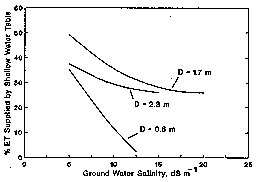Author:
Jan W. Hopmans
Professor of Water Science
Mark E. Grismer
Professor of Water Science
Donald W. Grimes
Emeritus
University of California, Davis
Drought Tip 92-27 is a publication series developed as a cooperative effort by the following organizations:
California Department of Water Resources - Water Conservation Office
Department of Land, Air and Water Resources University of California
USDA Drought Response Office
USDA Soil Conservation Service
If you have comments or suggestions, please email lawrweb@ucdavis.edu.
Last reviewed December 19, 2002
In soils with slowly permeable subsurface layers, applying irrigation water in excess of the amount the plant actually uses for transpiration creates ground water tables near the surface, which can be used to reduce irrigation requirements. Such ground water is referred to as a perched or shallow water table and is differentiated from a deep water table by its influence on plant growth. Shallow water tables are present in the central and western San Joaquin Valley and in other areas of the state.
A shallow water table can affect plant growth in various ways. When water tables approach the soil surface, root growth decreases and eventually stops because of aeration problems. Decreased root growth and activity limits water and nutrient uptake and adversely affects plant production. Aeration problems generally occur when water table depths are at between 50 and 100 inches below the soil surface, but may also be influenced by soil type and rooting depth.
The presence of a shallow water table increases the soil water storage available for plant transpiration and soil evaporation (ET). Root activity occurs in the unsaturated zone above the water table only. Thus, the soil water reservoir becomes available only if water moves against gravity from the shallow water table toward the plant roots by capillary rise. As a result, the extent to which shallow ground water contributes to plant transpiration depends on soil type and shallow water table depth.
Shallow water table contributions to plant water use are high in loamy soils compared to clay and sandy soils. Water table contributions decrease as the distance between the plant roots and the shallow water table increases.
Figure 1 shows the percentage of ET in cotton contributed by a shallow water table with varying water table depths and soil textures.

Figure 1. Grismer, M.E. and T.K. Gates. 1987. Contribution of shallow water table to cotton water use for various soil types. California Agriculture (41):3-4.
Even where irrigation water is of high quality, salts will accumulate near the soil surface because of plant water uptake. With rainfall and irrigation, these salts move to the ground water and increase salinity in shallow ground water. However, because of capillary rise, this leaching process can be reversed, bringing salts back to the root zone.
Increasing salt concentrations make extracting soil water more difficult for the plant roots. High soil salinity generally reduces root growth and plant water uptake and increases plant water stress compared to low soil salinity and comparable soil water storage capacity. Figure 2 shows the reduction in shallow water table contribution to plant water use with increased ground water salinity for clay and loamy soils. The reduction is more pronounced with shallower water tables. The contribution of shallow water tables to the ET of salt sensitive crops will be lower than that shown in Figure 2.

Figure 2. Grimes, D.W. and D.W. Henderson. 1986. Contribution of shallow water table to cotton water use as a function of water table depth and ground water salinity. Presented at the 1986 Summer Meeting, American Society of Agricultural Engineers.
Experimental data for cotton in California have shown that shallow water tables can contribute as much as 40% to 60% of the crop ET. Cotton is salt-tolerant and is thus less vulnerable to the increasing soil salinity created by capillary rise. In the short term, the use of shallow water tables will have a limited effect on soil salinity and crop production. In normal rainfall years, most of the salts brought into the root zone by capillarity will be leached back to the ground water by rainfall and pre-irrigations. However, managing soil salinity becomes important over the long term when maximum use of a shallow water table is encouraged for meeting crop ET requirements.
In fields with subsurface drainage systems, ground water tables can be artificially elevated by temporarily raising the discharge end of the drains in the drain sump with an elbow configuration. The water table would be elevated before the pre-irrigation and lowered again after harvesting to promote leaching by winter rains.
In summary, shallow water tables may significantly contribute to the total water demand of the crop, thereby reducing irrigation water requirements and drainage losses. However, if shallow water tables are to be used as a long-term strategy, the associated increase in soil salinity requires careful management.
